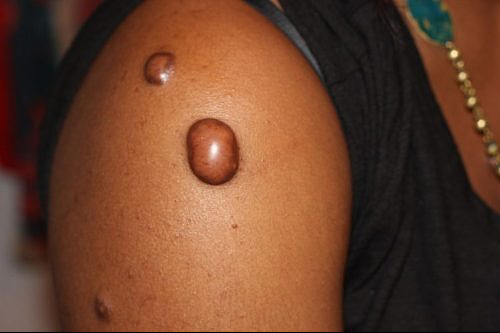Ever wonder why your scars tend to grow beyond the boundaries of the original site of a skin injury? Well, these raised scars are referred to as keloids. They are the result of irregular wound healing and can appear on anyone but African Americans, and Hispanics are 16 percent more likely to have them. Keloids form 15 times more frequently on Black than on caucasian skin.
What causes keloids?
Clinicians are still baffled as to why or how keloids form but skin trauma appears to be the most common explanation. Sometimes they can form for no solid reason. Anything that can cause a scar, can result in a keloid–burns, cuts, acne, surgery, puncture, chicken pox, insect bites, piercing, and even a tattoo. It might take as long as three months or more for a keloid to take shape after an injury. Keloids also tend to run in families.
How are keloids diagnosed?
Keloids are usually diagnosed by a physician, preferably a dermatologist. A doctor will determine whether the scar is a keloid by examining its size, location, and texture. Sometimes, a doctor might need a skin biopsy to rule out other kinds of skin growths.
What are the symptoms of keloids?
Suddenly pops up and grows slowly. It can take upwards of three months before you can even see a keloid on your skin. It might take months or even years before a keloid stops growing.
Raised scars. Keloids can appear as raised pink, red or purple scars with a flat surface. A keloid’s color may change from its original shade to a much darker hue and with even darker borders.
Different textures. A keloid feels different than its surrounding skin; it is soft and doughy although there are some that are hard and rough.
Various sensations. When keloids are growing, they may be itchy, tender or painful when you touch them. The sensations might stop once the keloid has stopped growing.
Where are keloids found?
Keloids can be found practically anywhere on the body. They are, however, most commonly found on the back, shoulders, chest, neck, and ears. As far as size, keloids can measure less than an inch to greater than a foot or more.
How are keloids treated?
There is no cure for keloids. They can be difficult to remove because they can return even after treatment; their high rate of recurrence is up to 50 percent. A doctor will typically aim to flatten, soften, or shrink a keloid by combining such treatment options as:
Cryotherapy uses extreme cold to treat keloids. It can be an effective way to reduce the size and hardness of keloids, and to help prevent further scarring.
Steroid injections can reduce the size of keloids and reduce swelling, redness, itching, and tenderness. Intralesional fluorouracil is a chemotherapy medication that can be injected into the scar tissue for patients who don’t respond to steroids.
Silicone dressings or gel can reduce the size and color of keloids.
Laser therapy can flatten larger keloids and reduce itchiness. This treatment can cause hypopigmentation or hyperpigmentation, blistering, and crusting, especially in people with darker skin.
Surgery removes the scar tissue, but its return is possible.
Compression therapy uses tight clothing or other devices to apply pressure to the keloid, which can reduce collagen and blood flow and decrease scar tissue.
Keloids are not life-threatening! They can, however, cause emotional issues in those who are affected by them because they can be unsightly and embarrassing.
Need more information about keloids? Visit the American Academy of Dermatology–aad.org











